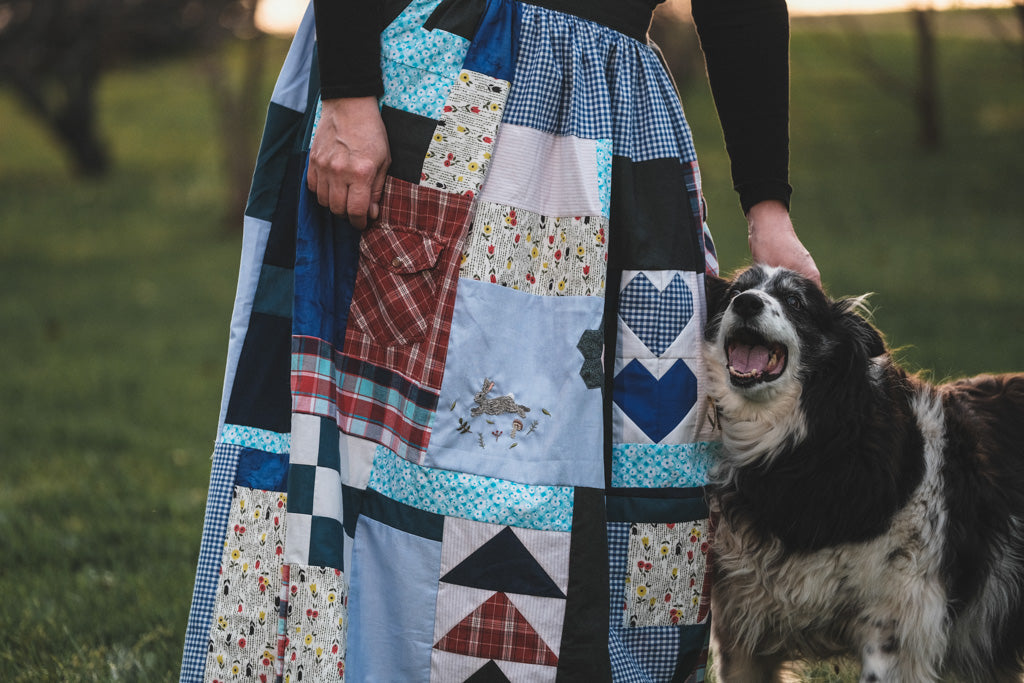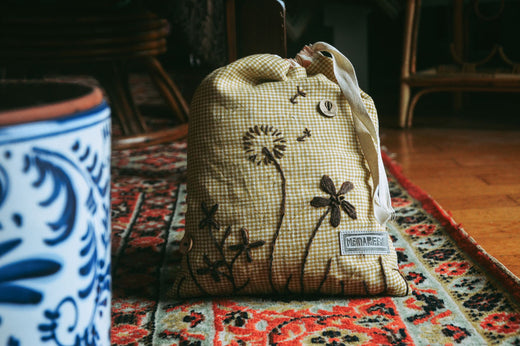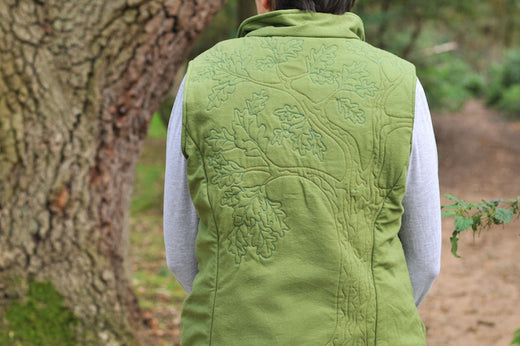When was the last time you took a deep dive into your fabric stash? What treasures might you find there? Storyteller Jen Martin hopes to inspire you to do just that - uncover that forgotten fabric and give it a new life!
Read on to see how Jen "re-newed" her husband's old button-up shirts, a collection of fabric scraps, and upcycled textiles into two beautiful Meadow Skirts, one for herself and one for her daughter.

Unlocking the Treasure Trove
As a passionate fabric collector, I've faced the considerable challenge of storing an ever-growing assortment of materials in my modestly sized sewing room. My collection is as eclectic as they come—hand-me-downs from friends' grandmothers, quilting cotton scraps, thrifted bedsheets and tablecloths, lightly worn clothing not suitable for donation, exotic batiks from past visits to Southeast Asia, aged wool suit jackets, self-tanned rabbit pelts and deer hides, and remnants of previous clothing projects.
Confronted with the limits of my storage situation, I've made a significant commitment to myself: for the next year, and potentially longer, I will exclusively sew using materials from my existing stash. This decision excites me as I envision revitalizing and renewing my diverse fabric collection.

Challenge One: The Patchwork Maxi Skirt
The first challenge in my year of stash sewing was to repurpose my husband's old cotton button-up shirts into something new. I set my sights on crafting a new maxi skirt, specifically the flowing Meadow Skirt. However, the generous fabric requirements of a maxi skirt and the nature of scrap utilization don't typically align seamlessly. Hence, I turned to the time-honored technique of patchwork.
The origins of patchwork are as varied as my fabric collection itself, with evidence found in ancient Egypt, across Asia, and among early North American settlers. Initially, patchwork was a method born out of necessity—a way to use up leftover fabric scraps or to extend the life of garments. Over time, it found a place in fashion, particularly during resource-strapped periods like World War II and the handmade revolution of the 1960s and 70s. During these times, patchwork not only solved practical problems but also became a symbol of individuality and resistance against mainstream fashion norms.

Beginning with a selection of harmoniously-colored cotton shirts and supplementing them with a few floral quilting cottons, I dove into a free-form patchwork style. My approach was methodical: maintaining square shapes, trimming excess fabric to keep the seams straight, and serging all seams to prevent fraying, especially since I wasn’t planning to line the skirt.
I incorporated several quilt blocks to add visual interest. After assembling a sufficiently large piece of fabric, I cut out the pattern pieces and sewed them together. The final touch was the embroidery of playful bunnies on some of the larger squares, which gave the skirt a whimsical and truly unique appearance.

Challenge Two: A Prairie Skirt for My Daughter

The next project was a long Meadow Skirt for my eldest daughter, who has developed a discerning taste in handmade clothing. She envisioned “a pretty skirt that goes all the way down to the floor.” Initially, I hoped to persuade her towards a patchwork design to utilize smaller fabric scraps, but she preferred a more unified appearance. Luckily, my stash provided. I unearthed a couple of thrifted bedsheets and a floral bath curtain that promised enough fabric for her vision. She chose the bath curtain for its petite florals, ruffle edge and desired prairie aesthetic. To add functionality, and knowing her penchant for collecting small treasures, I incorporated a gathered pocket from the Kea pocket pack into the design.
Since wearing her skirt for the first time, my daughter confessed that it makes her feel like a princess and she would gladly wear it daily if I was to let her. The joy of transforming this outdated bath curtain into a beautiful garment was profound, reminding me of the limitless possibilities hidden within materials often overlooked and undervalued.

A Challenge for You
Now, I extend a challenge to you, my fellow sewist. The next time you need fabric for a project, consider bypassing the conventional fabric store. Instead, explore thrift stores, rummage sales, or garage sales. Look at each item not for what it is but for what it could become. Transform old jeans into a chic satchel, repurpose a tablecloth or bedsheet into a stylish dress, or convert an old wool suit into cozy slippers. Even an outdated quilt can be reimagined into a trendy jacket or vest. All it takes is a bit of imagination and the courage to see potential where others see waste.
This approach does more than just ignite creativity; it promotes sustainability and conscientious consumption in our sewing practices. So, let's embark on this journey of transformation and renewal together. What treasures will you uncover in your fabric stash?







